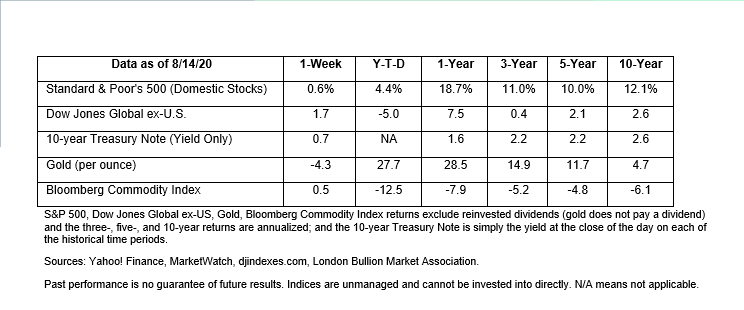
To say that this year has been a wild ride is probably an understatement.
We have probably seen the worst economic collapse since the Great Depression and Millions of Americans see themselves unemployed during this economic shutdown. For now the US economy has started to re-open and bouncing off its lows. However there is one question that every investor must now grapple with the extremely uncertain question of whether the U.S. economy will quickly recover or a more challenging work-out period is about to commence.
THE MARKETS
The Standard & Poor’s (S&P) 500 Index finished the week within a whisker of its February high, reported Randall Forsyth of Barron’s.1
It’s a remarkable feat. The stock market has recovered in just 175 days. Historically, comparable recoveries (those following market drops of 20 percent or more) have taken about four years, reported Vildana Hajric, Lu Wang, and Claire Ballentine of Bloomberg Quint.2
“The sharpness and speed of the downturn – and the immediacy of the overwhelming liquidity and fiscal response from the Federal Reserve and Congress – forestalled the kind of grinding, purgative action of typical bear markets, which wrings out excesses and resets valuations lower. There was also not the shift in market leadership that usually occurs in the crucible of a bear market,” reported Michael Santoli of CNBC.3
The recovery is also remarkable because it occurred in the midst of a recession (that some have labeled a depression4) and during a period of extraordinarily weak corporate earnings. It’s possible investors are focusing on the fact economic and earnings data has been ‘better-than-expected.’ For instance:
• The U.S. economy shrank by -32.9 percent during the second quarter. While that was better than the -34.7 percent forecast, the U.S. economy still lost about one-third of its value.5
• The blended earnings of companies in the S&P 500 Index were -33.8 percent during the second quarter, as of August 7, which is the latest FactSet Insight report available. While most companies have performed better than anticipated, their profits had fallen significantly.6
Last week, in a paper titled Reasons (Not) To Be Cheerful: Certainty, Absurdity, and Fallacious Narratives, GMO’s James Montier wrote, “Never before have I seen a market so highly valued in the face of overwhelming uncertainty. Yet today the U.S. stock market stands at nosebleed-inducing levels of multiple, whilst the fundamentals seem more uncertain than ever before.”7
The bottom line is the economy and company profits have contracted sharply while stock market valuations have rocketed higher. The sonic boom of performance startled many market professionals. Strategists tracked by Bloomberg expected the S&P 500 to finish December at 3,117 or about 8 percent lower than it started.2 They may be wrong, but they may be right. No one is certain what lies ahead.

LIFE: PANDEMIC STYLE.
The pandemic has changed the ways people all over the world think and interact with one another. It has also inspired artists and designers to find solutions to pressing problems, such as the need for social distancing. Here are a few inventions that may help us cope with pandemic life and help us find a new normal:
• Glass lamps to dispel loneliness. Imagine you turn on a light in your home and it turns on a light in your parent’s home or your grandparent’s nursing home to let them know you’re thinking about them. Video artist Alexander Lervik’s website describes his invention like this:8
“…a set of glass lamps shaped as rocks, which have been given the capacity of apprehending human touch and communicating with other rocks to express community and closeness. Perhaps you own one rock, and an older relative owns another so that they can sense when you touch your stone, thinking of them. The work offers a chance to think about all those old people who are lonely and in need of human touch.”
• Devices to deliver anxiety-free dining. In the Netherlands, a restaurant has installed glass cabins on its patio that can accommodate two or three diners. Reuters reported, “Waiters wear gloves and transparent face shields, and use a long board to bring dishes into the glass cabins to ensure minimal physical contact with customers.”9
Travel and Leisure reported some restaurants may make indoor dining more palatable by installing plexiglass cylinders that hang from the ceiling like lampshades. Diners settle inside the cylinders as they are seated.10
• Hands-free door handles in grocery stores. To overcome pervasive reluctance to touch doorknobs and door handles in public places, a Finnish supermarket installed curved handles that allow shoppers to pull open cooler doors with their forearms, reported the World Economic Forum.11
Weekly Focus – Think About It
“There will come a time when you believe everything is finished. That will be the beginning.”
--Louis L’Amour, Novelist12
Best regards,
Niels Buksik
P.S. Please feel free to forward this commentary to family, friends, or colleagues. If you would like us to add them to the list, please reply to this email with their email address and we will ask for their permission to be added.
* These views are those of ANCHORY LLC, and not the presenting Representative or the Representative’s Broker/Dealer, and should not be construed as investment advice.
*This newsletter was prepared by ANCHORY LLC.
*Government bonds and Treasury Bills are guaranteed by the U.S. government as to the timely payment of principal and interest and, if held to maturity, offer a fixed rate of return and fixed principal value. However, the value of fund shares is not guaranteed and will fluctuate.
*Corporate bonds are considered higher risk than government bonds but normally offer a higher yield and are subject to market, interest rate and credit risk as well as additional risks based on the quality of issuer coupon rate, price,yield, maturity, and redemption features.
*The Standard & Poor's 500 (S&P 500) is an unmanaged group of securities considered to be representative of the stock market in general. You cannot invest directly in this index.
*All indexes referenced are unmanaged. The volatility of indexes could be materially different from that of a client’s portfolio. Unmanaged index returns do not reflect fees, expenses, or sales charges. Index performance is not indicative of the performance of any investment. You cannot invest directly inan index.
*The Dow Jones Global ex-U.S. Index covers approximately 95% of the market capitalization of the 45 developed and emerging countries included in theIndex.
*The 10-year Treasury Note represents debt owed by the United States Treasury to the public. Since the U.S. Government is seen as a risk-free borrower,investors use the 10-year Treasury Note as a benchmark for the long-term bond market.
*Gold represents the afternoon gold price as reported by the London Bullion Market Association. The gold price is set twice daily by the London Gold Fixing Company at 10:30 and 15:00 and is expressed in U.S. dollars per fine troy ounce.
*The Bloomberg Commodity Index is designed to be a highly liquid and diversified benchmark for the commodity futures market. The Index is composed of futures contracts on 19 physical commodities and was launched on July 14, 1998.
*The DJ Equity All REIT Total Return Index measures the total return performance of the equity subcategory of the Real Estate Investment Trust (REIT) industry as calculated by Dow Jones.
*The Dow Jones Industrial Average (DJIA), commonly known as “The Dow,” is an index representing 30 stock of companies maintained and reviewed by the editors of The Wall Street Journal.
*The NASDAQ Composite is an unmanaged index of securities traded on the NASDAQ system.
*International investing involves special risks such as currency fluctuation and political instability and may not be suitable for all investors. These risks are often heightened for investments in emerging markets.
*Yahoo! Finance is the source for any reference to the performance of an index between two specific periods.
*The risk of loss in trading commodities and futures can be substantial. You should therefore carefully consider whether such trading is suitable for you in light of your financial condition. The high degree of leverage is often obtainable in commodity trading and can work against you as well as for you. The use of leverage can lead to large losses as well as gains.
*Opinions expressed are subject to change without notice and are not intended as investment advice or to predict future performance.
*Economic forecasts set forth may not develop as predicted and there can be no guarantee that strategies promoted will be successful.
*Past performance does not guarantee future results. Investing involves risk,including loss of principal.
* The foregoing information has been obtained from sources considered to be reliable, but we do not guarantee it is accurate or complete.
*There is no guarantee a diversified portfolio will enhance overall returns or outperform a non-diversified portfolio. Diversification does not protect against market risk.
*Asset allocation does not ensure a profit or protect against a loss.



.jpg) Niels Buksik
Niels Buksik